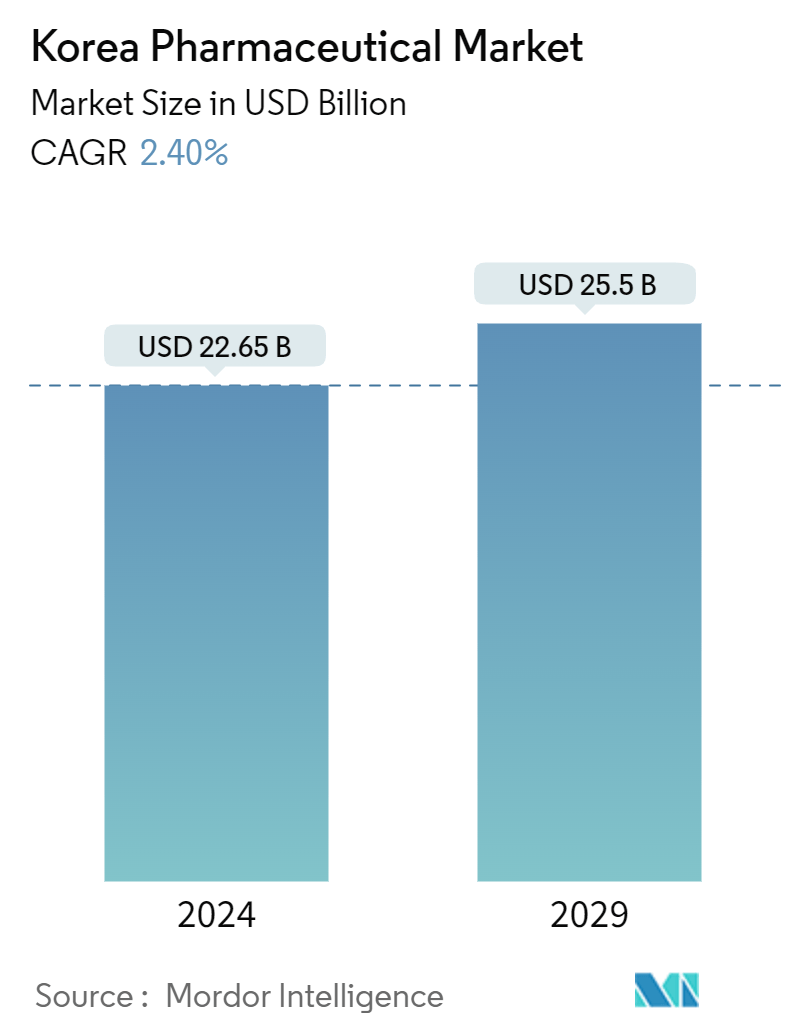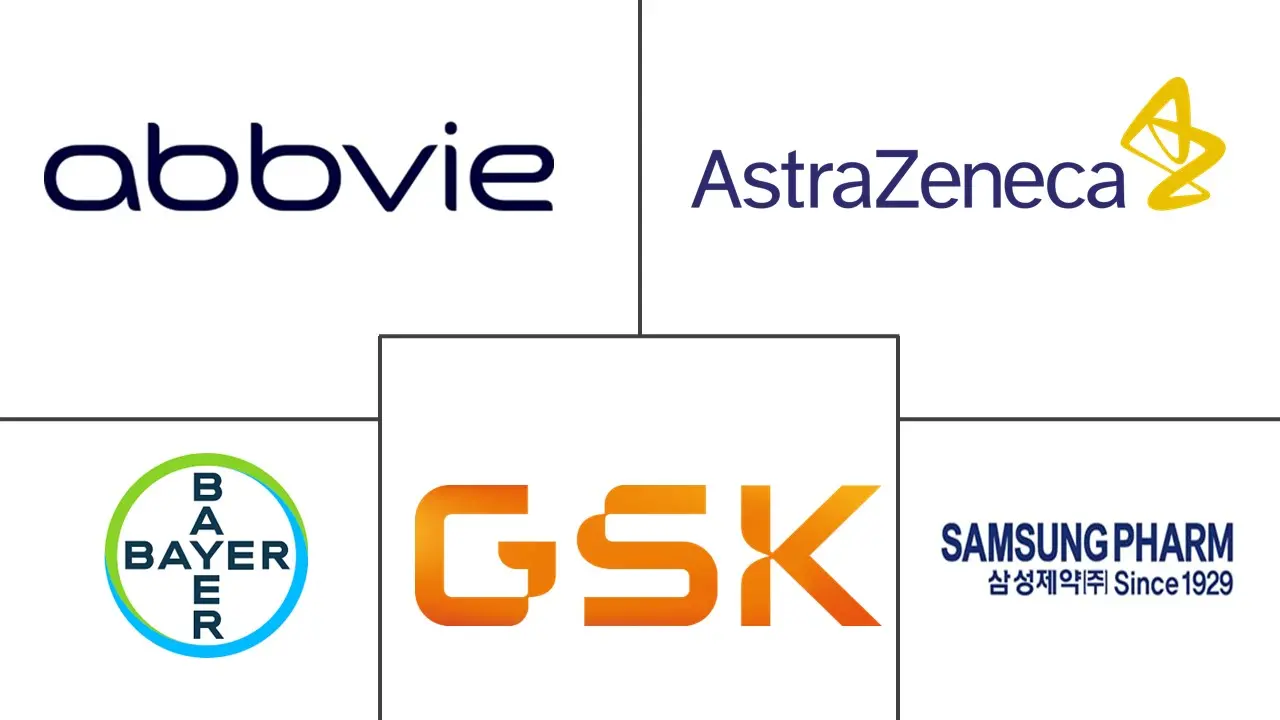Market Size of Korea Pharmaceutical Industry

| Study Period | 2019 - 2029 |
| Base Year For Estimation | 2023 |
| Forecast Data Period | 2024 - 2029 |
| Market Size (2024) | USD 22.65 Billion |
| Market Size (2029) | USD 25.5 Billion |
| CAGR (2024 - 2029) | 2.40 % |
Major Players
*Disclaimer: Major Players sorted in no particular order |
Korea Pharmaceutical Market Analysis
The Korea Pharmaceutical Market size is estimated at USD 22.65 billion in 2024, and is expected to reach USD 25.5 billion by 2029, growing at a CAGR of 2.40% during the forecast period (2024-2029).
The COVID-19 pandemic affected the healthcare sector. The initial phase of the pandemic has impacted the market significantly due to restrictions on movement, supply chain disruption, travel bans, etc. Although the demand for OTC drugs and prescription drugs decreased during the pandemic, the need for OTC drugs for the common cold and fever increased, which boosted the market's growth. The import of medicinal and pharmaceutical products decreased in 2021 (3,847.1 million) compared to 2020 (4,055.5 million). However, with the released COVID-19 restrictions and resumed import and export activities, the demand for pharmaceutical products is expected to increase over the forecast period.
Factors such as the rising incidence of chronic diseases, such as cardiovascular diseases and diabetes, the increasing geriatric population, and the growing research and development activities and expenditures in the country are expected to drive the market's growth.
The rising number of chronic diseases such as cardiovascular diseases, diabetes, hypertension, cancer, neurological diseases, and others are the key factor driving the market growth. For instance, according to GLOBOCAN, in 2020, there were around 230,317 new cancer cases in South Korea, with 28,713 new cases of stomach cancer, 28,651 prostate cancers, and 25,814 breast cancer. According to the 2022 statistics published by the International Diabetes Federation in the 10th edition of 2021, in South Korea, 3.5 million people were living with diabetes in 2021. As per the same source, this number is projected to reach 3.9 million by 2030. Thus, the expected highly diabetic population is at high risk of developing other chronic diseases, such as liver diseases and kidney and cardiovascular diseases, which is anticipated to boost the demand for pharmaceutical drugs over the forecast period.
The rising geriatric population is contributing to the growth of the market studied. For instance, according to the 2022 statistics published by the United Nations Population Fund, in South Korea, a large proportion of the living population is aged 15-64 and accounts for 71% of the total population in 2022. As per the same source, 17% of the population is aged 65 years and above in 2022. Thus, the rising geriatric populations are more prone to develop chronic diseases such as cardiovascular diseases, neurological disorders, and cancer, raising the demand for effective therapeutics, which accelerates the company's research and development activities to develop drugs and medicines along with other pharmaceutical products., thereby propelling the market's growth.
The increasing government initiatives to launch awareness programs to educate people regarding cancer and other chronic diseases contribute to the market's growth. For instance, the Korean Breast Cancer Society announced the Global Breast Cancer Conference 2023 (GBCC 2023), which will be held in April 2023 in Korea. Such activities are expected to significantly boost the demand for cancer drugs and vaccines, propelling the market's growth.
The growing research and development spending in the country creates opportunities for the company to increase its R&D activities to develop advanced and effective therapeutic or biological drugs and vaccines for treating chronic diseases. This is expected to increase the availability of pharmaceutical drugs in the market, boosting the market's growth. For instance, as per the Federation of Korean Industries (FKI) 2021 report, 93.1 trillion won (USD 75.4 billion) was spent on research and development activities in the country in 2020, accounting for 4.81% of its GDP.
The rising company focus on developing pharmaceutical products for treating various chronic diseased as the growing adoption of various business strategies such as collaboration, acquisition, partnerships, and increasing product launches in the country is also expected to boost the market's growth over the forecast period. For instance, in February 2022, Pharma Korea Co. Ltd, a South Korean subsidiary of Ono Pharmaceutical Co. Ltd, received approval from the South Korean Ministry of Food and Drug Safety (MFDS) for Opdivo (nivolumab) Intravenous Infusion (Opdivo), a human anti-human PD-1 monoclonal antibody for two adjuvant treatments and three combination treatments. In January 2022, ABL Bio Inc., a clinical-stage biotech company, collaborated and entered into a worldwide license agreement with Sanofi to develop and commercialize a treatment for Parkinson's disease and other potential indications. The treatment, ABL301, is a preclinical stage bispecific antibody that targets alpha-synuclein and insulin-like growth factor 1 receptor (IGF1R) with bolstered penetration of the blood-brain barrier.
However, the stringent regulatory scenario is expected to restrain the growth of the pharmaceutical market over the forecast period.
Korea Pharmaceutical Industry Segmentation
As per the scope of this report, pharmaceuticals are referred to as prescribed and non-prescription drugs. These medicines can be bought by an individual with or without the doctor's prescription and are safe for consumption for various illnesses with or without the doctor's consent.
The Korean pharmaceutical market is segmented by therapeutic category (anti-infectives, cardiovascular, gastrointestinal, anti-diabetic, respiratory, and others) and drug type (prescription drugs (branded drugs and generic drugs) and over-the-counter drugs). The report offers the value (in USD million) for the above segments.
| By Therapeutic Category | |
| Anti-Infectives | |
| Cardiovascular | |
| Gastrointestinal | |
| Anti Diabetic | |
| Respiratory | |
| Other Therapeutic Categories |
| By Drug Type | ||||
| ||||
| OTC Drugs |
Korea Pharmaceutical Market Size Summary
The Korean pharmaceutical industry is poised for steady growth over the forecast period, driven by several key factors. The market is experiencing a resurgence following the disruptions caused by the COVID-19 pandemic, which had initially led to a decline in demand for certain pharmaceutical products due to supply chain issues and movement restrictions. However, the easing of these restrictions has led to an anticipated increase in demand for pharmaceutical products. The rising incidence of chronic diseases, such as cardiovascular conditions, diabetes, and cancer, coupled with an aging population, is significantly propelling market expansion. The increasing focus on research and development, supported by substantial government and private sector investments, is fostering innovation and the development of advanced therapeutics, further bolstering market growth.
The competitive landscape of the Korean pharmaceutical market is characterized by the presence of major global players who are actively engaging in strategic collaborations, acquisitions, and product launches to strengthen their market positions. The prescription drug segment is expected to dominate the market, driven by the high prevalence of chronic diseases requiring long-term treatment. Additionally, the respiratory segment is anticipated to grow due to the rising incidence of respiratory conditions among the aging and pediatric populations. The market's growth is also supported by government initiatives aimed at raising awareness about chronic diseases and the ongoing development and approval of new drugs. Despite the promising growth prospects, the market faces challenges from stringent regulatory requirements that could impact the pace of innovation and market entry for new products.
Korea Pharmaceutical Market Size - Table of Contents
-
1. MARKET DYNAMICS
-
1.1 Market Overview
-
1.1.1 Healthcare Expenditure
-
1.1.2 Pharmaceutical Imports and Exports
-
1.1.3 Epidemiology Data For key Diseases
-
1.1.4 Regulatory Landscape/Regulatory Bodies
-
1.1.5 Licensing and Market Authorization
-
1.1.6 Pipeline Analysis
-
1.1.6.1 By Phase
-
1.1.6.2 By Sponsor
-
1.1.6.3 By Disease
-
-
1.1.7 Statistical Overview
-
1.1.7.1 Number of Hospitals
-
1.1.7.2 Employment in the Pharmaceutical Sector
-
1.1.7.3 R&D Expenditure
-
-
1.1.8 Ease of Doing Business
-
-
1.2 Market Drivers
-
1.2.1 Rising R&D Expenditure
-
1.2.2 Rising Incidence of Chronic Disease such as CVD and Diabetes
-
-
1.3 Market Restraints
-
1.3.1 Stringent Regulatory Scenario
-
-
1.4 Porter's Five Force Analysis
-
1.4.1 Threat of New Entrants
-
1.4.2 Bargaining Power of Buyers/Consumers
-
1.4.3 Bargaining Power of Suppliers
-
1.4.4 Threat of Substitute Products
-
1.4.5 Intensity of Competitive Rivalry
-
-
-
2. MARKET SEGMENTATION (Market Size by Value - USD million)
-
2.1 By Therapeutic Category
-
2.1.1 Anti-Infectives
-
2.1.2 Cardiovascular
-
2.1.3 Gastrointestinal
-
2.1.4 Anti Diabetic
-
2.1.5 Respiratory
-
2.1.6 Other Therapeutic Categories
-
-
2.2 By Drug Type
-
2.2.1 Prescription Drug
-
2.2.1.1 Branded Drugs
-
2.2.1.2 Generic Drugs
-
-
2.2.2 OTC Drugs
-
-
Korea Pharmaceutical Market Size FAQs
How big is the Korea Pharmaceutical Market?
The Korea Pharmaceutical Market size is expected to reach USD 22.65 billion in 2024 and grow at a CAGR of 2.40% to reach USD 25.5 billion by 2029.
What is the current Korea Pharmaceutical Market size?
In 2024, the Korea Pharmaceutical Market size is expected to reach USD 22.65 billion.

